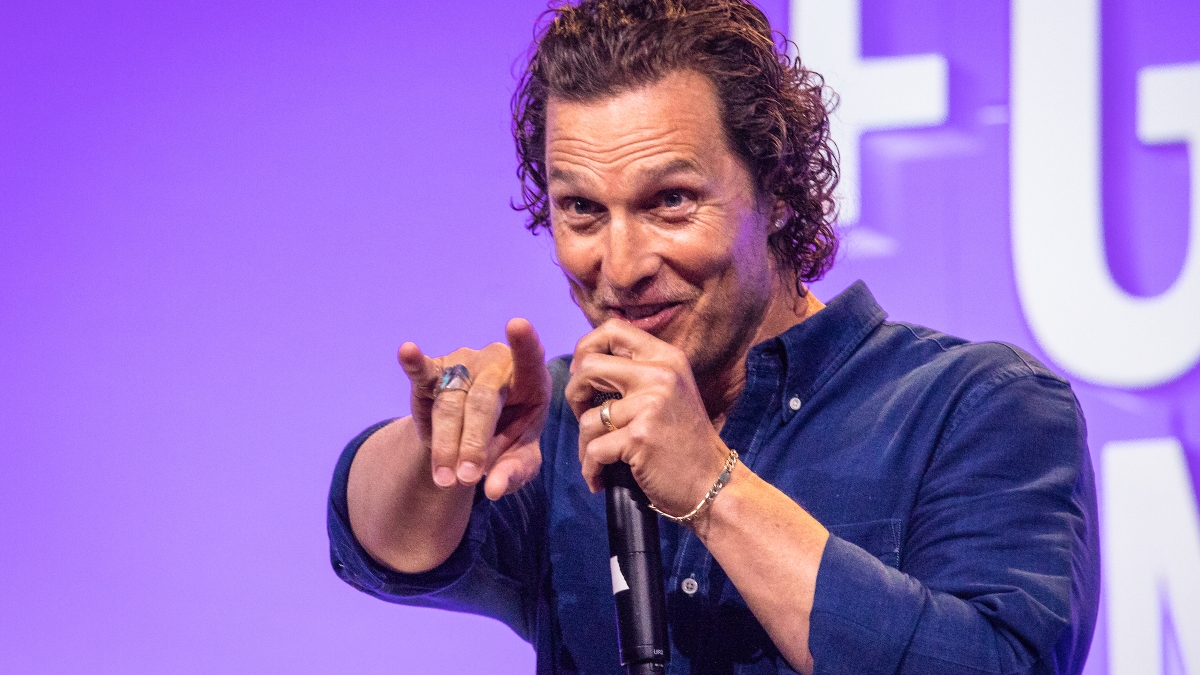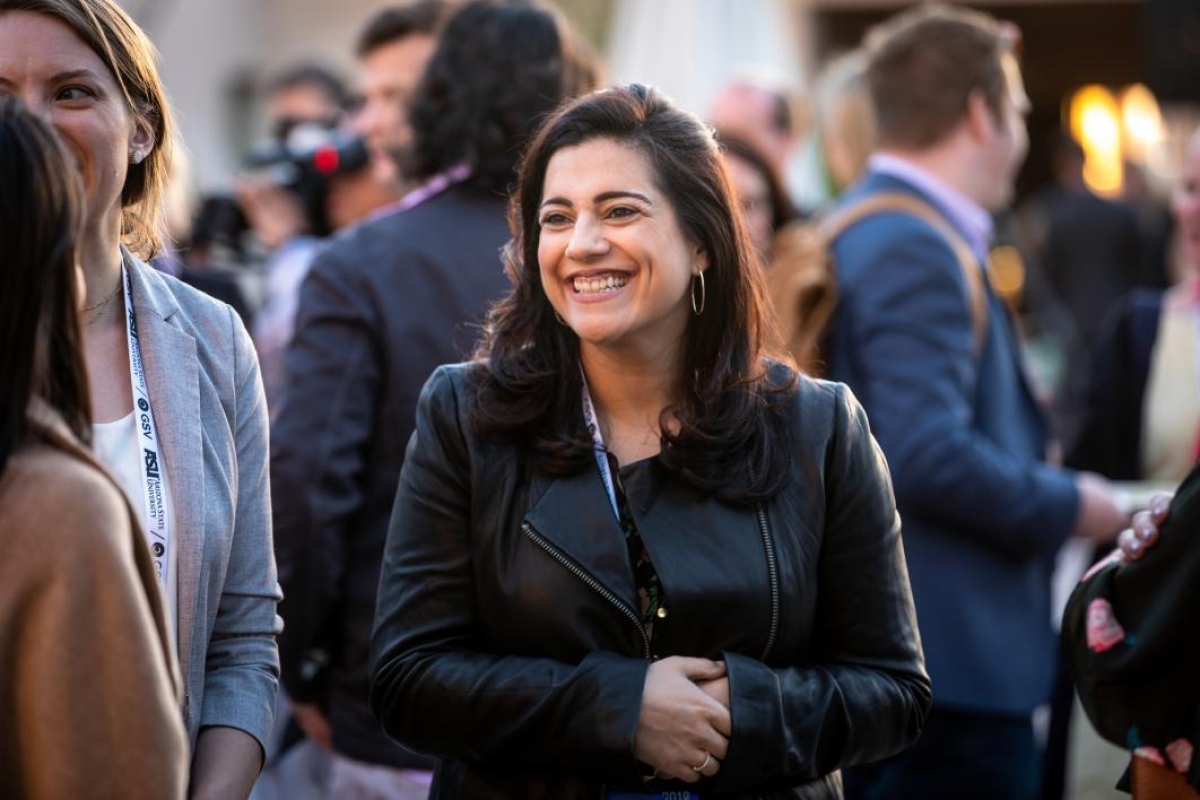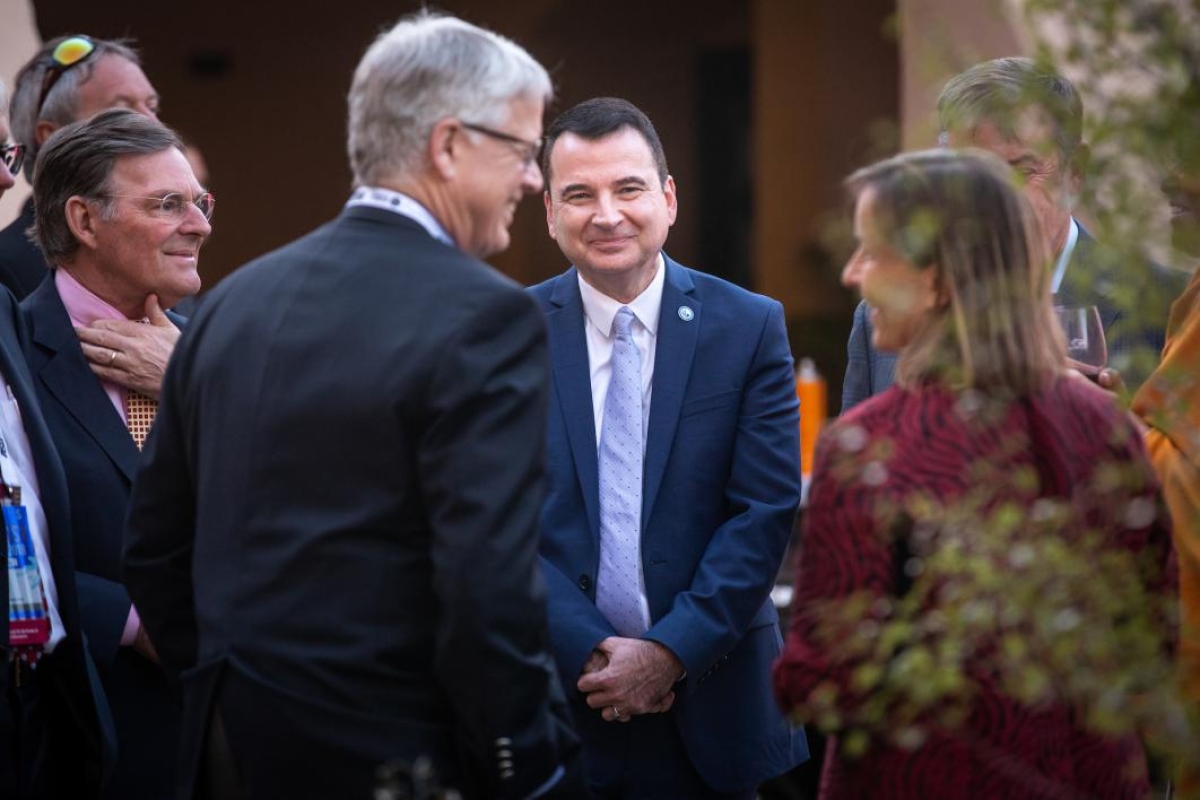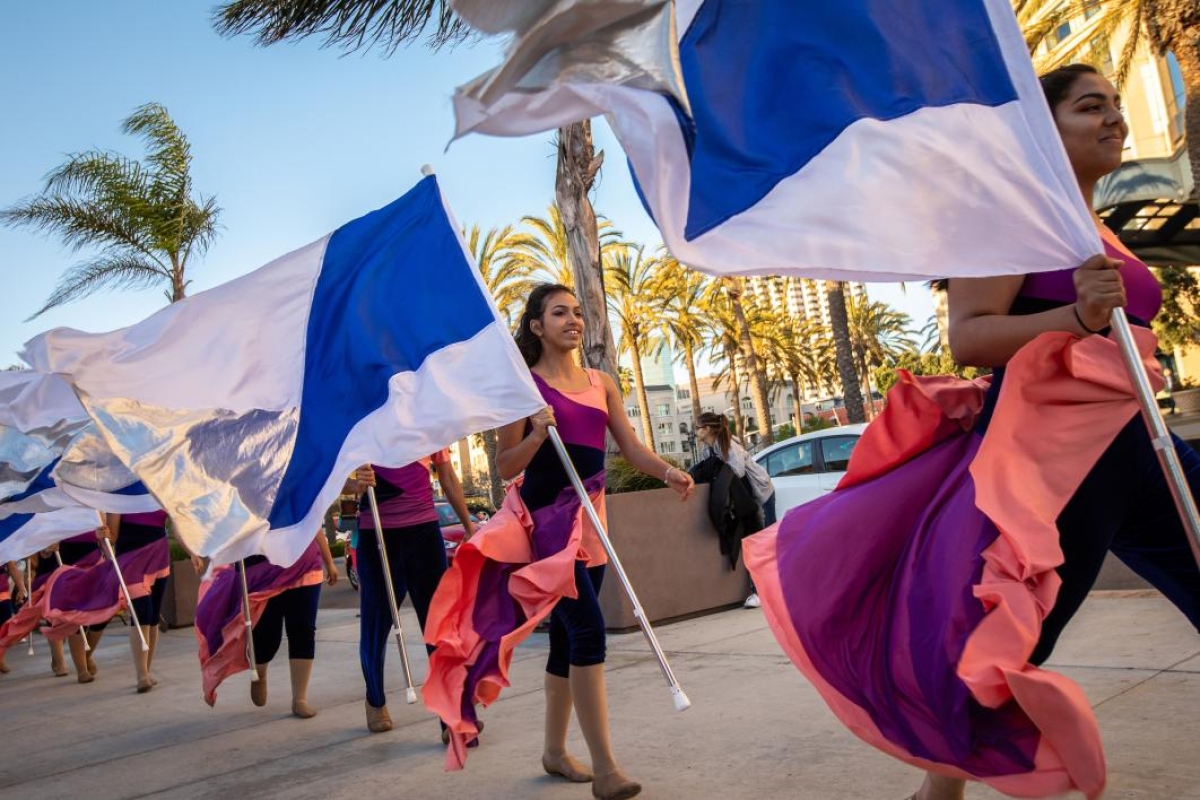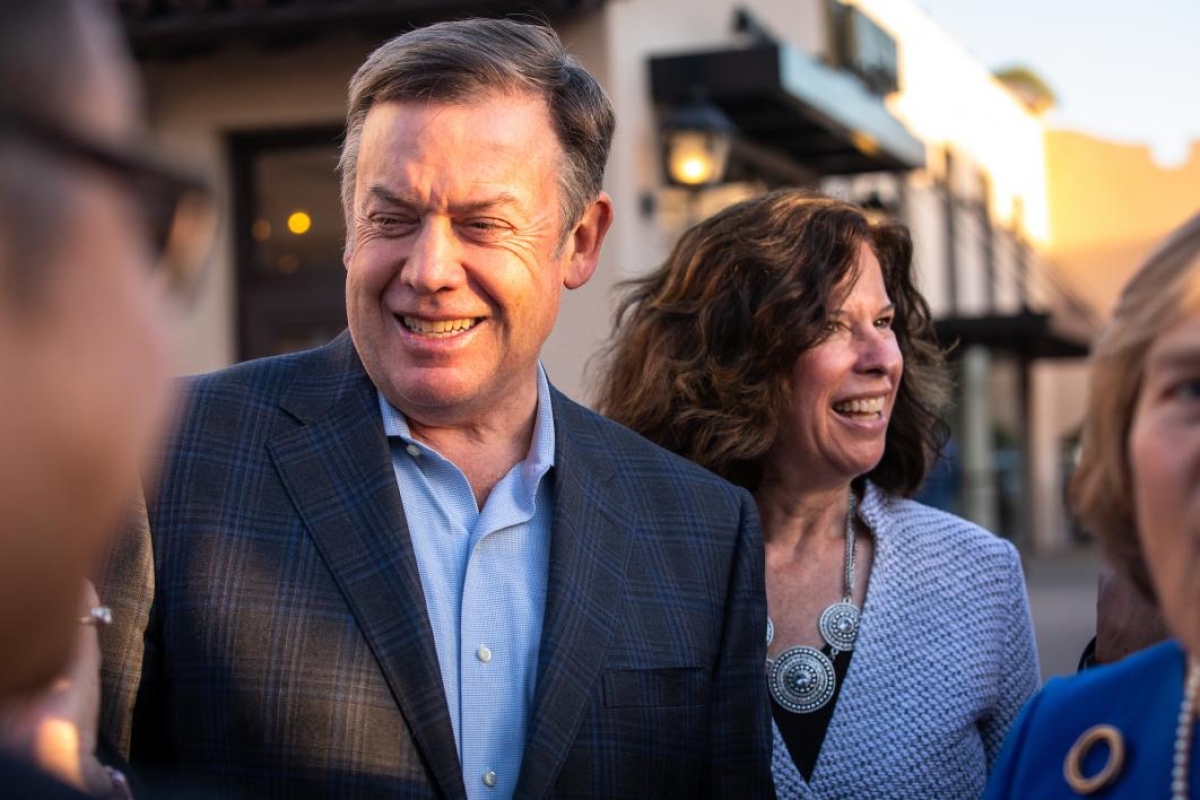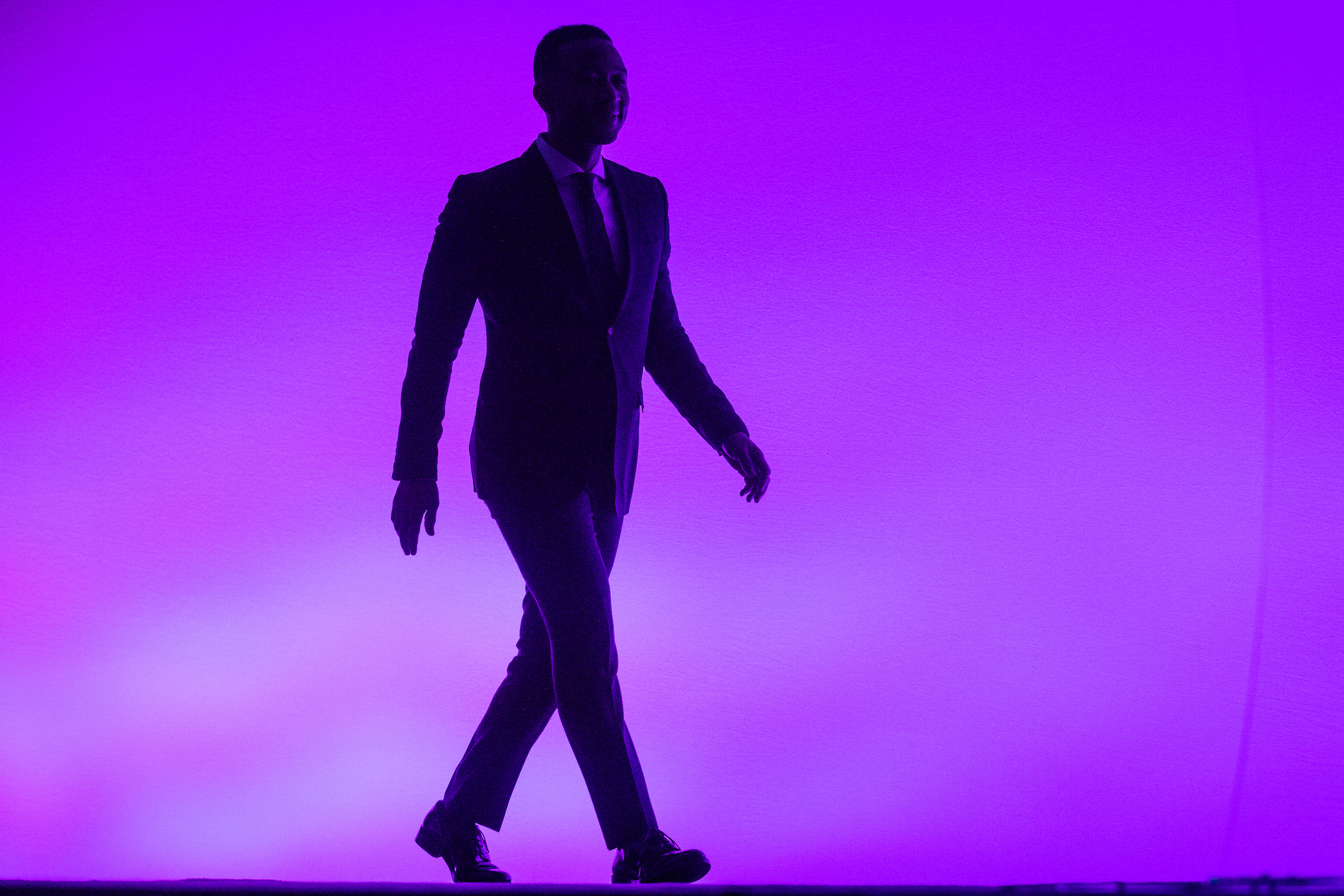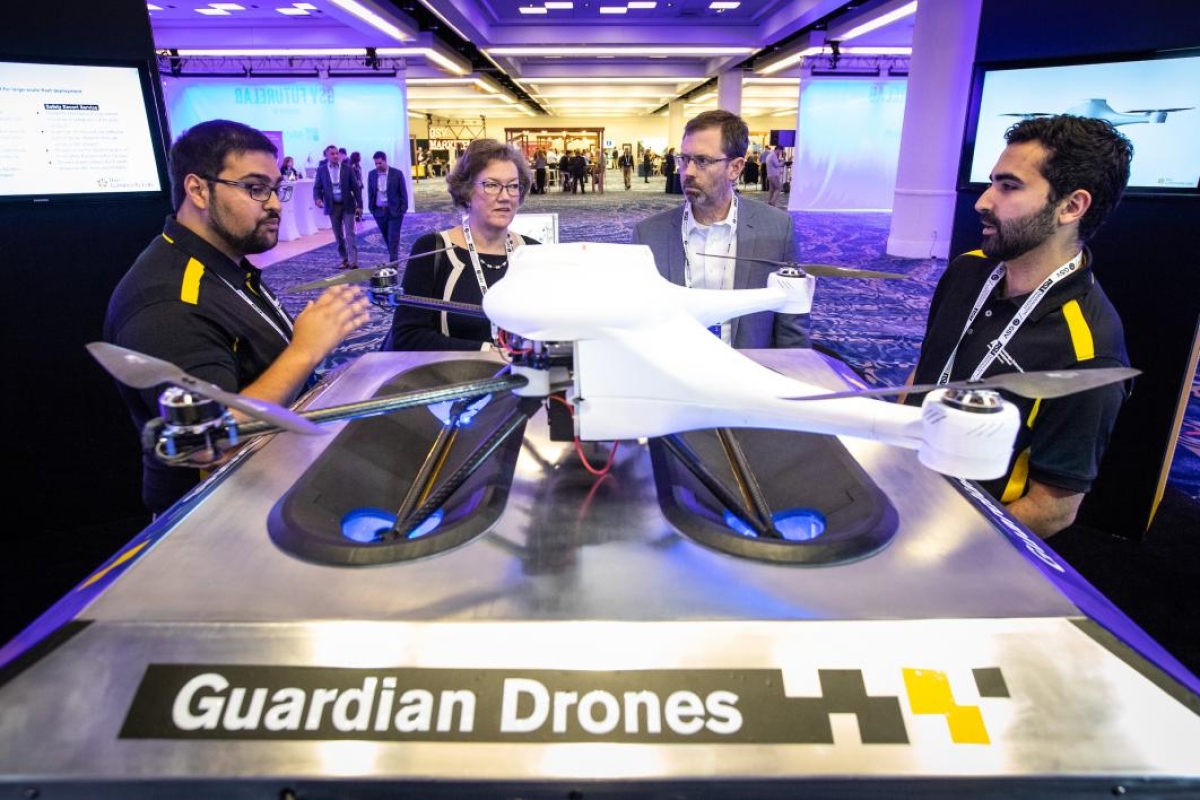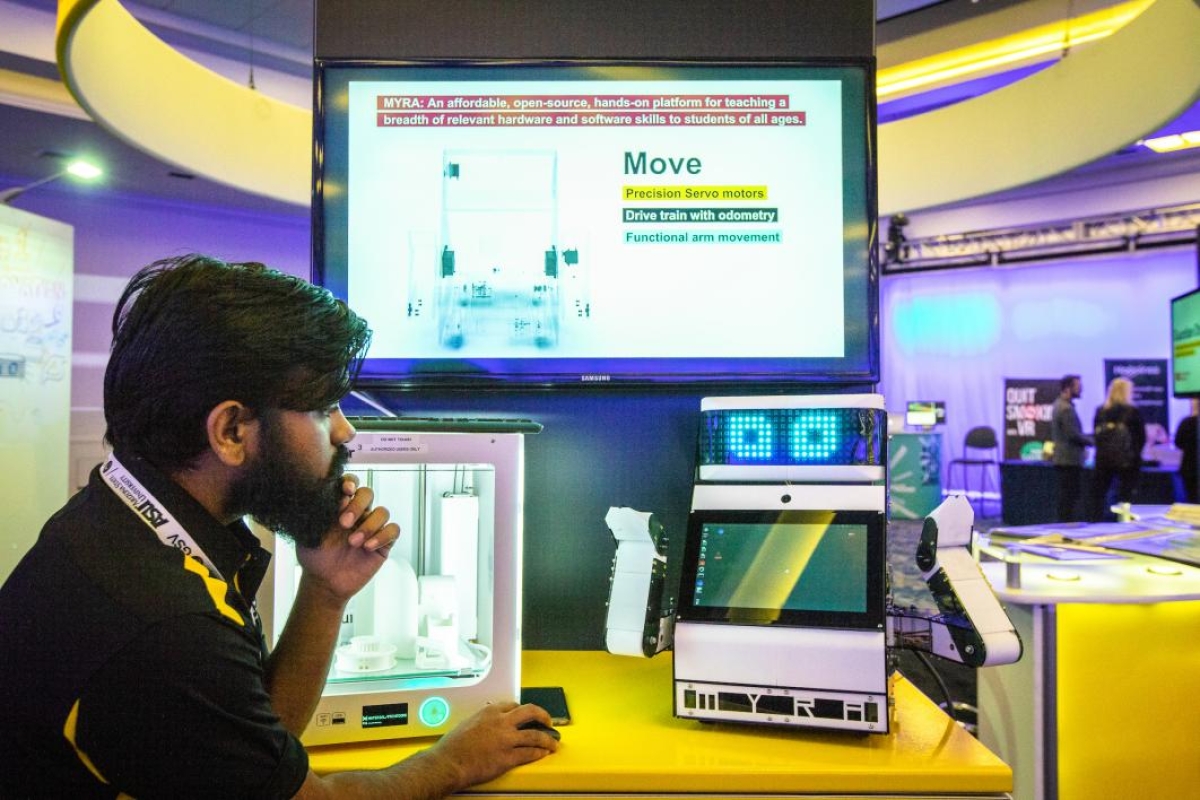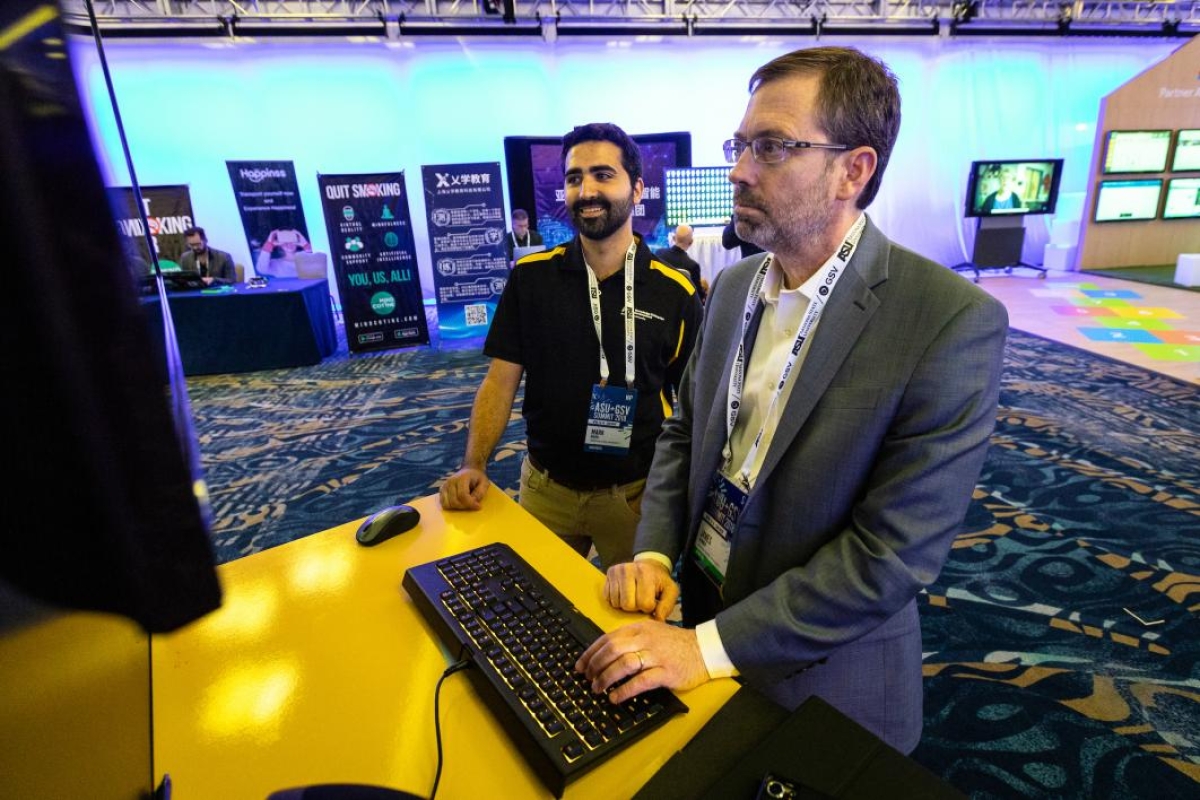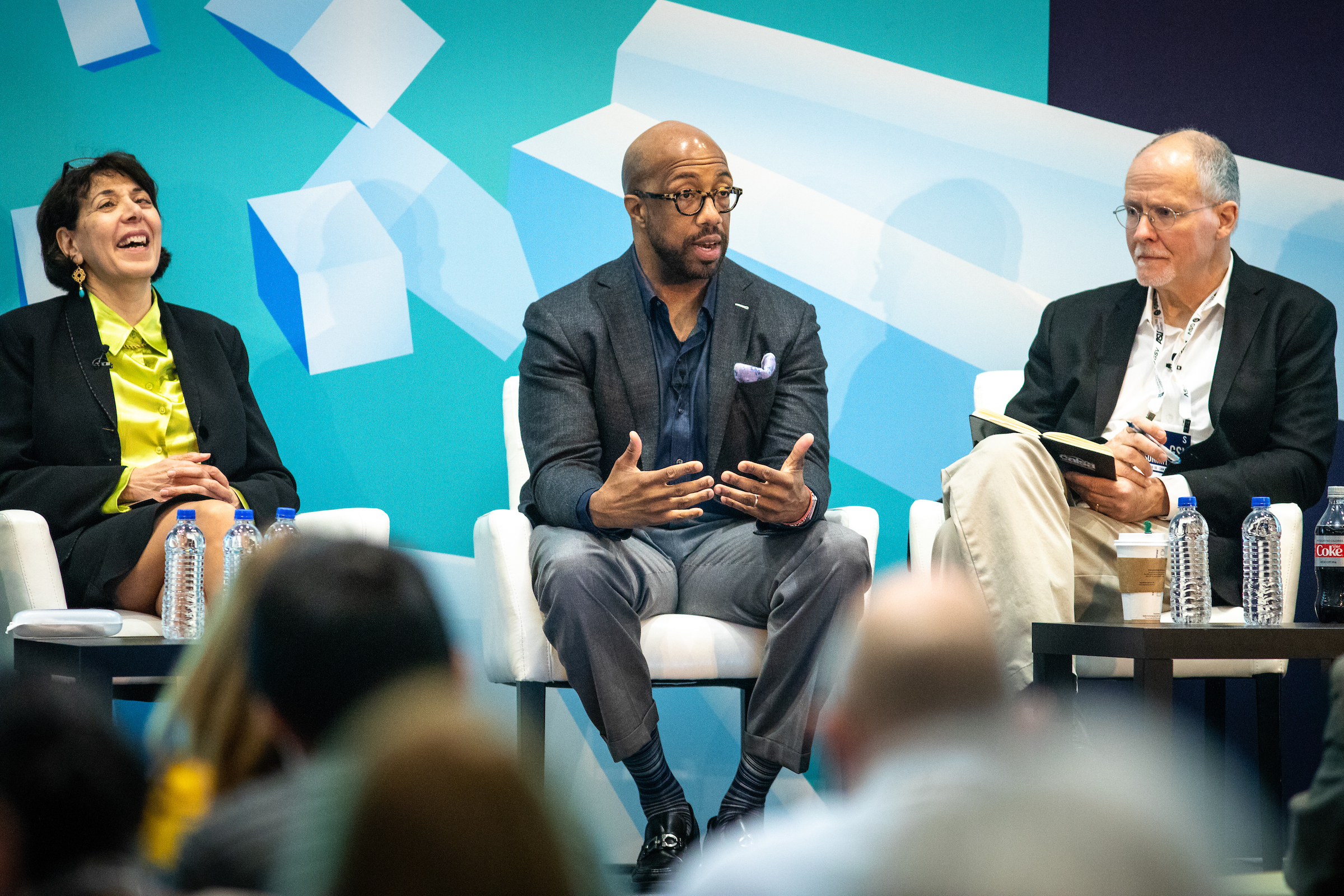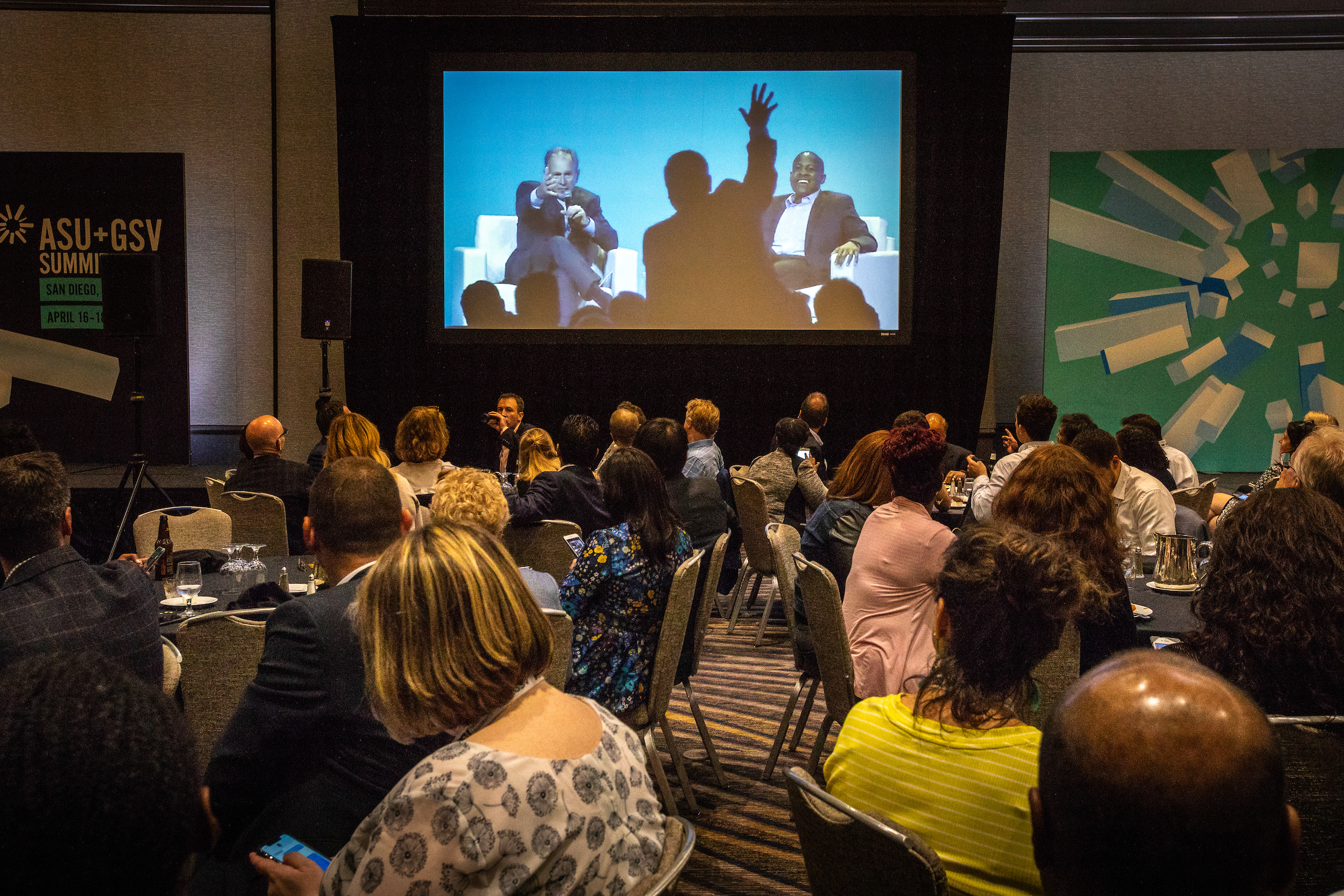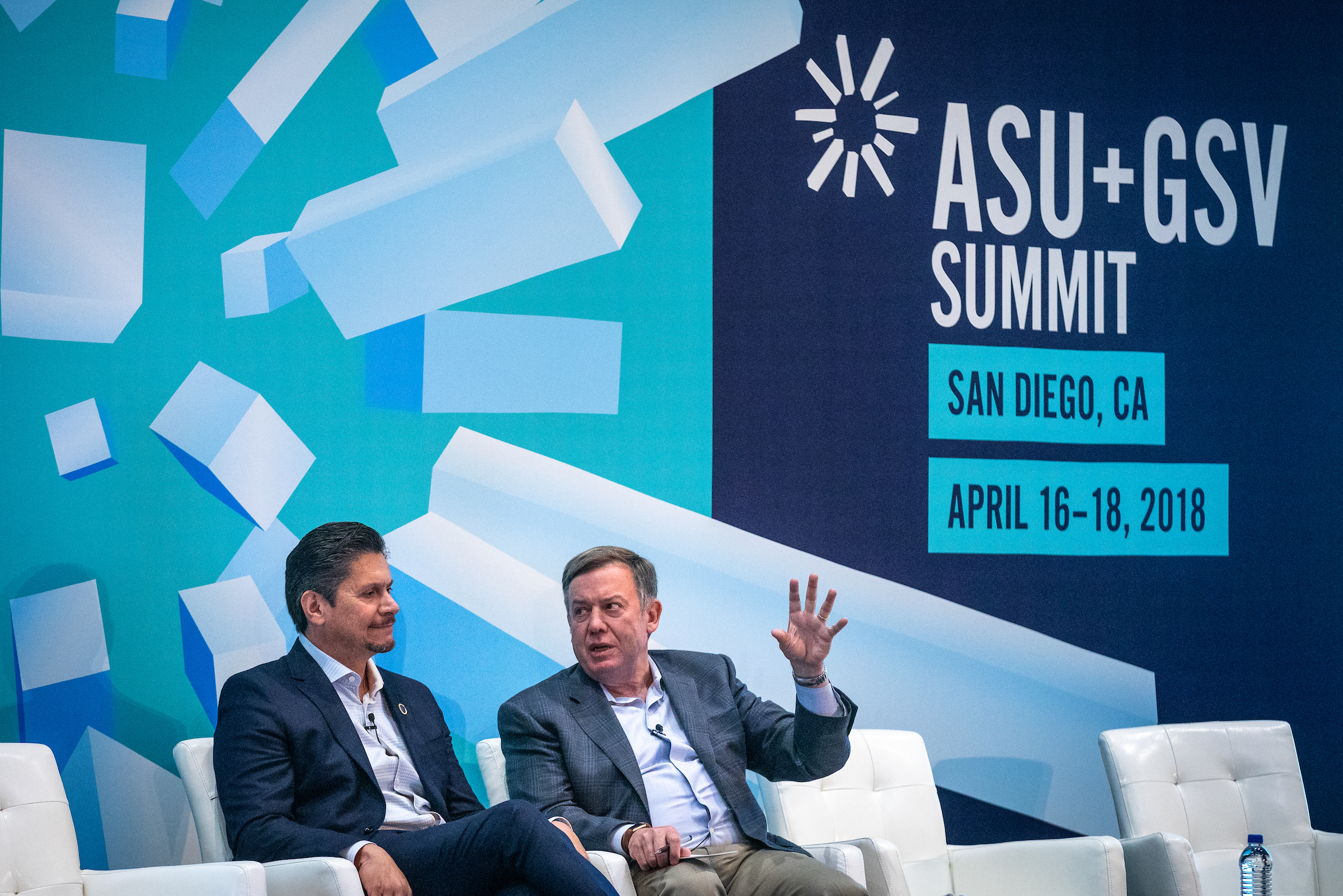Editor's note: ASU Now will be covering this week's ASU + GSV Summit in San Diego, an event that started in 2010 with a collaboration between Arizona State University and Global Silicon Valley that attracts more than 4,000 leaders from across the learning and talent spectrum and serves as a platform for elevating dialogue about raising education and career outcomes through scaled innovation. Find highlights below from some of the hundreds of panels, including videos, quotable quips and links to longer stories.
All right, all right, all right: Famous folks on the power of education
10:15 p.m. Wednesday, April 18
Judges (from left) Dan Rosensweig, CEO of Chegg; Betty Liu, founder and CEO of Radiate; and actor Matthew McConaughey confer before awarding a $50,000 Venture Award to Freddy Vega, co-founder and CEO of Platzi, at the Closing Dinner + Keynote on Wednesday. Platzi is an online education tool serving primarily Spanish-speaking countries. Photo by Charlie Leight/ASU Now
Mexico has progressed rapidly over the past generation thanks to better education, according to Vicente Fox, a businessman and the former president of Mexico. Fox delivered the final keynote address Wednesday, an evening that focused on education's power to transform and also featured Hollywood star power: Matthew McConaughey speaking about his student-focused foundation.
Changing the way people approach college
8 p.m. Wednesday, April 18
Eric Waldo, executive director of Michelle Obama's Reach Higher Initiative at Civic Nation, talks about how the U.S. has fallen in its worldwide educational ranking of post-secondary completion, and the strategies that could turn that around.
Video by David Jinks/ASU
What if we got rid of credits? Or semesters?
5:55 p.m. Wednesday, April 18
Arthur Levine, president of the Woodrow Wilson Foundation and former president of the Teachers College at Columbia University, talks about how the system of university education — based on credits and semesters — is outdated. Here, he shares what might replace that.
Video by David Jinks/ASU
Chronicle report: Emerging trends in U.S. higher ed
5:20 p.m. Wednesday, April 18
What forces will shape higher education over the next year? Goldie Blumenstyk, senior writer for the Chronicle of Higher Education, discussed key findings from The Chronicle’s 2018 Trends Report. Here are some emerging trends:
- The American campus ‘under siege’: “What we’re seeing is an incredible rise of incidents on campuses. That’s because a lot of organizations have discovered that a campus is a good place to make a statement about campuses as bastions of liberal thought. Incidents related to white supremacy, like leafletting, have tripled.”
- Students in charge: “There are a lot of students still disenfranchised, like students at community college, but what we’re seeing at a lot of institutions, in part because tuition is making up a larger piece of the pie, is the balance of power shifting. There’s a lot more market-demand curriculum, nicer dining halls and more of a focus on career services.”
- Loss of global prestige: “Because of difficulty with visas and DACA, the United States is a less popular destination for students from overseas. The U.K., Australia and New Zealand are making big pushes to go after the international market the U.S. seems to be turning its back on.”
- Student success up front: “This is not just about adaptive software platforms or success coaches. We’re seeing a systemic approach that looks different from a few years ago. The best example of this is at Georgia State, which is offering completion grants. They use data to identify students who are close to graduation and give them a small completion grants so they don’t drop out.”
- Black college renaissance: “The more we see hostility to people of color on campuses, the more that students of color will go to institutions where they find things friendly. We’ve seen record enrollment in (historically black colleges and universities), and we’ve seen increased enrollment of Latino students and Asian students at HBCUs.”
Let's hear from the founders of the summit
4:45 p.m. Wednesday, April 18
Video by David Jinks/ASU
The outlook for middle-skills jobs
4:30 p.m. Wednesday, April 18
What will the future of work be like for people who want a middle-class lifestyle but no college degree? Cross-sector panelists weigh in.
Digitalization and Education
3:30 p.m. Wednesday, April 18
As the world becomes more connected, it also becomes more complex. Jaime Casap, education evangelist at Google, discussed how students today must be prepared to solve global problems that haven’t been defined yet, using technology that hasn’t been invented, in roles that do not exist. To thrive in this new era, learners need to know how to learn, problem solve, think critically, and how to use digitization tools.
“Machine learning is core to everything that we do. The key question is, making sure that machine learning, artificial intelligence — we have to make sure that it’s inclusive, that it’s not biased. We have to make sure that we’re not solving for an old problem, but that we’re solving for a new problem. When we’re using machine learning and artificial intelligence to fix the homework problem, when we know homework doesn’t work, are we really solving anything?
“People always ask kids, ‘What do you want to be when you grow up?’ That question makes no sense. Instead, I want to ask kids, ‘What problem do you want to solve?’ Because that gets us closer to what Danny Pink talks about in his book, ‘Drive,’ about what motivates all of us as human beings: purpose — what problem do you want to solve? The second question is, ‘How do you want to solve it?’ Autonomy. And then the most important question in education is the third one around mastery. What do you need to learn to solve that problem? What are the knowledge, skills and abilities that you need to have in order to solve that problem?”
Athletics intrinsically linked with education
2:30 p.m. Wednesday, April 18
Sports and education experts formed a team to talk about the relationships that exist between college athletics, academics and the pro leagues — both good and bad. ASU President Michael Crow, adidas North America President Mark King and New York Times sportswriter Karen Crouse weighed in on the topic.
adidas' Mark King on what sport has meant in his life
2 p.m. Wednesday, April 18
Video by David Jinks/ASU
Where is testing going?
11 a.m. Wednesday, April 18
Modern measurement of learning efficacy and human skills is rapidly evolving, and machine learning and AI technologies are at the heart of much of the change. Leaders from a diverse set of organizations discussed the future of testing and assessment and other forms of measurement, at a panel called "From Hype to Insight: Measurement is Woke," led by moderator Karen Cator, CEO of Digital Promise.
Joanna Gorin, vice president, research, Educational Testing Service: I think what we need to make sure that we are doing, while we’re changing and evolving, is think of what we can take advantage of in terms of all of these technologies to better measure what it really means to learn and to know something, but not to lose sight of the fact that we still have to evaluate the data as evidence, and often times there is more data than is really meaningful to be able to do what we need to do.
Lou Pugliese, Action Lab managing director and Senior Innovation Fellow, ASU: At ASU…what we’re finding is that as we begin to go up the level of sophistication, meaning starting with these early tree adaptive systems, to more algorithm-based adaptive systems that really require better diagnostic models, we can start to see the ability to move from just measuring cognition and intelligence surface knowledge, to really measure competence in terms of what the students can actually do. I think that’s most important thing that AI accomplishes.
How to achieve real innovation
10:50 a.m. Wednesday, April 18
Several experts addressed change in universities at a panel titled, “Change Agents or Kamikaze Pilots? Can We Have Unfettered Innovation in HigherEd?”
Jeffrey Selingo, special advisor and professor of practice, ASU: Innovation can be a fuzzy word. What does innovation mean, but more importantly what does unfettered innovation look like? Higher education is a rightly regulated industry in the U.S. and that word unfettered makes some people nervous.
Marni Baker-Stein, provost and chief academic officer, Western Governors University: I think innovation is an empty word in and of itself. It is a tool in the toolkit to get to the most important thing, which is serving every learner better and better all the time. In that context, there is no such thing as unfettered innovation. I’ve never had an experience in my professional life and in working with companies to drive innovation, where there weren’t constraints. That’s what makes innovation innovative. How do we work within those constraints to drive change?
Selingo: As we think about innovation at existing institutions, do you have to change the culture first and then follow with a strategy?
Kevin Guthrie, president, Ithaka: We did a case study of ASU three years ago. We interviewed 50 people. It’s primarily cultural. The degree to which it’s strategic is clarity of vision. (ASU President) Michael Crow has experienced a clarity of vision and it’s taken 15 years. The first five years, there wasn’t a lot movement. We forget that. Whether you agree or don’t agree, what’s happening there is that there’s consistency that’s changing the culture. We asked what percentage of the faculty are on board with this story. And what all the leadership said was 80 percent are on board. It’s taken long enough that the people who are not are gone. Clarity of vision followed by a cultural change in terms of people, design and goals is critical to innovation within an institutional complex.
Diverse array of topics kicks off final day of ASU + GSV Summit
8 a.m. Wednesday, April 18
Read about all the highlights from the morning session, including a conversation about school violence with former U.S. Secretary of Education Arne Duncan, a panel with ASU President Michael Crow and this year's McGraw Prize winners, and an expert discussion of the complexities of the Chinese and American education systems.
Fete for McGraw Prize winners
11 p.m. Tuesday, April 17
After the John Legend keynote and the panel discussion, ASU + GSV Summit participants were led by marching band to a reception in honor of the McGraw Prize winners.
John Legend and social justice in the spotlight
10:30 p.m. Tuesday, April 17
Oscar, Golden Globe and 10-time Grammy Award winner John Legend takes the stage to deliver the Tuesday afternoon keynote address at the ASU+GSV Summit 2018 in San Diego. Photo by Charlie Leight/ASU Now
John Legend headlined an evening focused on social justice, as the singer-activist and a panel of experts focused on what our communities must do to cultivate talent in all groups, in particular the incarcerated.
Transitioning from school to the workplace
5 p.m. Tuesday, April 17
What are the best ways to prepare graduates for success post-graduation? ASU leaders talk about how the university's role has changed, going beyond the traditional work of a career services office.
Apple VP on unlocking potential
4:40 p.m. Tuesday, April 17
At a talk about technology unlocking students' potential, John Couch reflected on his years as Apple’s vice president of education, and his soon-to-be-released book, “Rewiring Education,” examining how technology can be used to address a number of K-12 challenges.
“We need a new set of A-B-Cs. 'A' is access. We do not have equal access. We don’t have it in the U.S., and we don’t have it around the world. 'B' is the students are capable of much more than being consumers of content. They can be creators of content. And 'C,' code. And I don’t say coding because I want everyone to be a coder. But the process to code is the same process to solve a problem, to start a company,” he said.
“The new learning pedagogy really becomes a symbiotic relationship between the teacher and the student and the community to solve real, relevant problems. And the students become the creators; they collaborate so they leverage each other’s talents and they take on challenges.”
And now for some cool gadgets
4:20 p.m. Tuesday, April 17
The workplace value of arts and humanities
3:55 p.m. Tuesday, April 17
STEM fields can steal the headlines, but at the "Future of Arts and Humanities in a Changing World of Work" panel, arts and humanities were in the spotlight.
Alexander Hochman, senior director, University of San Francisco Career Services Center: If anyone hasn’t checked out LinkedIn’s new monthly reports that they are doing by region, they are worth looking at. For the April report, in San Francisco, the top 10 skills that are in overabundance are all coding, and that was a surprise to me because I’m always worried that our students aren’t learning how to code, especially if they are a liberal arts major. And the top 10 skills that were the most desirable, were all your typical humanities skills.
Christian Garcia, associate dean and executive director, University of Miami: When I have a parent come to the career center and say, "Well, I don’t want Johnny studying English or humanities," I use the data to really show that those students are just as successful as our business majors or engineering majors in terms of finding jobs, in terms of salaries. And if you look beyond that first job, second job, five years down the line, they’re doing just as well and sometimes even better than those students. So I let the data speak for itself.
Getting a foot in the door in Silicon Valley
2:50 p.m. Tuesday, April 17
Cassie Nielsen, the vice president for talent at VMG Partners, offers a question she uses in interviews as she recruits executives for placement, during the "View from the Front Lines of Talent in Silicon Valley" panel Tuesday. Photo by Charlie Leight/ASU Now
For new graduates who have their sights set on working in Silicon Valley, a panel of recruiters talked about how they hire in a panel titled, “View from the Front Lines of Talent in Silicon Valley."
What technology will change the workforce?
Marian Pond, vice president, executive talent, Lightspeed Venture Partners: When you look at the sheer amount of employees that need to be brought in, I think human resource technology platforms that are leveraging the power of artificial intelligence are drastically changing the talent landscape. The recruiting staffing industry in the U.S. alone is $400 billion. Through these platforms, they’re able to identify the candidates quicker and shorten the recruiting time dramatically.
Ryan Bulkoski, partner in artificial intelligence and digital practice, Heidrick & Struggles: MIT recently made public this device that allows a human to communicate with a machine without vocalizing words. By determining the neuromuscular signals in your mind, it can pick up the conversation with 92 percent accuracy. How does that change the job market? It would drastically speed up jobs that are heavy in original content creation. Individuals who may have been hampered form birth not being able to speak can enter the workforce in more exciting capacities.
Is talent from Silicon Valley worth the hype?
Pond: It depends. There are a lot of amazing engineers in the Bay Area that have a lot of experience working with very complex enterprise solutions, but it comes at a cost. Compensation is crazy high and I don’t think there’s a lot of loyalty. A consumer company can be built with far less resources, especially technology talent.
Bulkoski: So many clients say they want to meet clients from Facebook, Amazon, Apple and Google. I ask, "What’s on your wish list?" One, the person will make a big impact. Two, we can make a huge press release. Three, they’ll bring a bunch of friends with them to New York or Pittsburgh. But there are risk factors. One is — is your organization set up from a cultural perspective to allow that person to be a success? Do you have a lot of politics? Second — how will you keep that person when they get a call 12 months later?
Educational needs in the Arab world
2:30 p.m. Tuesday, April 17
Video by David Jinks/ASU
“The challenges in the Arab world are not unlike challenges in global communities around higher education, but they happen to be more acute,” Maysa Jalbout, founding CEO of the Abdulla Al Ghurair Foundation for Education, said in a Tuesday midday panel about improving education in Arab countries through a partnership with ASU.
The panel, which included ASU President Michael Crow, discussed how the refugee crisis requires swift action and change, which many traditional universities are not designed to handle.
Redefining the land-grant university for the 21st century
2:00 p.m. Tuesday, April 17
Andy Rosen, the chairman and CEO of Kaplan Inc., speaks at a panel discussion on "Kaplan and Purdue University, Redefining the Land-Grant University for the 21st Century" on Tuesday at the ASU+GSV Summit. Photo by Charlie Leight/ASU Now
Purdue University’s acquisition of Kaplan University was characterized as “the most talked about business move on the higher education landscape in 2017.” The new university resulting from the transaction — Purdue University Global — has just recently been announced. The leaders who put this transformative transaction together — Kaplan's Andrew Rosen and Purdue's Steven Schultz and Frank Dooley — discussed what it means for their organizations and for higher education overall.
Andrew Rosen, chairman and CEO, Kaplan, Inc.: The question which gets posed to anybody that’s trying to do something different in higher ed is — well, it’s a different modality that you’re using, or a different set of students, and whether you serve them with excellence or not is less important than whether you’re serving that same population in the same way. What Purdue could have done is said, we’re going to try and protect the existing Purdue brand from anybody thinking we’re doing something different, and then they would have rejected this idea. Or, they could say, we’re a land-grant institution whose job is to serve the community that we’re part of. And there are working adults who don’t have access to excellence and we need to help provide that.
Steven Schultz, legal counsel, Purdue University: In a way, this is history repeating itself because a similar thing happened after World War II when Purdue, West Lafayette decided to expand and create regional campuses — up near the steel mills of Gary and Fort Wayne where there’s a lot of manufacturing activity — to give these guys who came back from the war a chance to go to college on the GI Bill in ways that they would not have been able to do. So this is, for the 21st century, another extension of the land-grant vision in the same way that that was for the latter part of the 20th century.
Frank Dooley, senior vice provost for teaching and learning and professor of agriculture economics, Purdue University: One of the things that I think is somewhat unique about this transaction is going with the market differentiation approach. Down the road what I think makes us successful is, are we able to influence ourselves? What can we learn on the West Lafayette campus that they’ve been doing for the past decade that is really a smart way to do education?
The role of AI in education
Noon Tuesday, April 17
Panelists explored the ethical, economic and educational implications of the rise of artificial intelligence during the "Global Benefit or Massive Dislocation: What the Rise of AI Means for Education and the Economy" event.
Marlo Gaddis, interim chief technology officer, Wake County (N.C.) Public School System: The wrong path that we seem to go to with AI is that AI replaces the human element. Part of being intentional in the work in education is making sure that we are still keeping a forward-thinking relationship piece so that our kids and our adults are having conversations and our adults know our students to best meet the needs of those kids.
Elijah Mayfield, vice president of new technologies, Turnitin: The big thing that some ed tech companies are recognizing is that if you want to serve students with machine learning tools, you need to meet them where they’re at. You should build an interface that helps students feel good about their work, helps them feel empowered to grow and helps them feel like they fit in in the community, in their school and with their teacher.
Andrew Krumm, director of learning analytics research, Digital Promise: The modern machine learning paradigm of person and interface, and ignoring the social context makes sense when you’re recommending restaurants and connecting with friends and so forth. In a complex social organization like a school, there’s so many other drivers of that behavior, of that signal that you’re detecting. I think a lot of the metaphors that we take from other industries really fall apart quite quickly when you actually put one of these things in a classroom with students.
Education tech outlook in Southeast Asia
11:40 a.m. Tuesday, April 17
Several experts discussed educational technology in Southeast Asia in a panel titled “Emerging Tigers.”
Jennifer Lee, adviser and investor at Edukasyon.ph, a college-preparation platform based in the Philippines: Take the Philippines. You have a 100 million population, economic growth, huge willingness to spend on education and a population that’s very engaged technologically. They were one of the first to do mobile banking. In Vietnam, 40 percent of net income after taxes is spent on educational services, and that’s true at every age, for very young kids but also in adult continuing education. But is there a good enough outcome there for an investor sitting in Silicon Valley?
Tuan Pham, CEO and founder of Topica, an education-technology company based in Vietnam: In the U.S., you guys have a great K-12 education system and a great university system. In Southeast Asia there is no K-12 system. So we’re not competing with the legacy system. But in Vietnam and Thailand, very few people speak fluent English and can’t understand a training course in English, so we when we bring in programs, we have to make sure they’re translated.
Tu Ngo, co-founder and chief product officer of Yola, an English-language educational technology company based in Vietnam: I grew up in Vietnam and went to college in the U.S. My partners and I have a lens of how we’re training the next generation of Vietnamese. They need language, but they need a new future. We have to build critical-thinking skills. We do a lot of empowerment so the students can learn about social issues. They use English to present their innovative ideas.
Shaking up higher ed goals
10 a.m. Tuesday, April 17
Michael Sorrell (center), president of Paul Quinn College in Dallas, talks about the challenges of a college with a 1 percent graduation rate as part of a panel discussion on "Higher Ed Radical ReBoot" on Tuesday. Photo by Charlie Leight/ASU Now
During a session called "Higher Ed Radical ReBoot," panelists discussed the major changes in store for colleges and universities.
Dan Greenstein, senior strategy advisor – education, Bill & Melinda Gates Foundation: At scale, labor economists suggest that colleges and universities are on track to produce 11 million fewer credentialed individuals than the national workforce requires. That means every university and college across the country has to improve credentialing capability by 6 or 7 percent every year until 2025. How many people actually know a university that’s doing that?
Michael Sorrell, president, Paul Quinn College: Revolutions don’t start from above, they start from below. They start from people who are upset and dissatisfied. So we actually listen to our students. We asked them, "What is it you need to make your lives better?’
John Katzman, CEO, The Noodle Companies, LLC: The biggest obstacle for most of us is execution. There are plenty of good ideas and good schools and really interesting approaches, and the delta in the end is the team you have, and can you just deliver critical, scalable, visual results?
The power of grit and perseverance
9:25 a.m. Tuesday, April 17
During her keynote speech at Tuesday morning's breakfast session, Angela Duckworth talked about the meaning of grit — the tendency to pursue long-term goals with perseverance — and how anyone can cultivate it.
“When I grew up, I had this domineering father who repeatedly reminded me that I was not the most talented person he had ever met. It did leave me with a lifelong fascination with achievement. Where I diverged from my father’s view of the world is that I discovered through personal experience and scientific research is that there’s not enough of a role for effort.
“When I say grit, I don’t just mean being a hard worker and being resilient when bad things happen. I also mean, ‘Do you love what you do and do you stay in love with what you do, a kind of sustained passion that matches that perseverance?’ I think schools have a role in helping kids develop this worth ethic and resilience.
“The data shows that as you get older, the grit gets higher. That is the maturity principle. We want to see this growth but we want to see it on a faster timetable. Can we accelerate that development? That is my entire life’s work. I will go to my grave trying to reverse engineer great lives.
“You need deliberate practice — set a stretch goal. You need 100 percent focus. You need feedback that’s rich in information. And you need reflection, getting that learner to be OK with not doing everything right.
“Grit is not being invincible. It’s being vulnerable and being able to be helped by people who love you.”
Presidential perspective
9:45 p.m. Monday, April 16
An overflow room filled with more than 500 people listen to an often-comical former President George W. Bush reminisce with Ozy Media's Carlos Watson during the keynote fireside chat at the ASU+GSV Summit on Monday evening. Photo by Charlie Leight/ASU Now
"If that guy can paint, so can I": Read about who inspired former President George W. Bush's painting hobby, what he considers one of the most significant pieces of civil rights legislation ever approved, what he was not able to accomplish as president and more from his Monday evening keynote chat at the ASU + GSV Summit.
Personalized learning is often neither personalized nor learning
6 p.m. Monday, April 16
“The right content, to the right student, at the right time”: Panelists discuss the challenges and opportunities of personalized learning.
What is personalized learning?
5:45 p.m. Monday, April 16
Phil Regier, university dean for educational initiatives and CEO of EdPlus at Arizona State University, discusses the situations where personalized and adaptive learning are important, and how exactly the process works.
Video by David Jinks/ASU
Breaking code, breaking barriers
4:15 p.m. Monday, April 16
How did women's colleges help win World War II? Writer Liza Mundy explains in her primetime talk and expounds on the legacy of women in tech in the video below.
Video by David Jinks/ASU
Rethinking libraries
3:45 p.m. Monday, April 16
A panel titled “Libraries as Innovation Agents in the 21st Century” addressed how libraries are staying relevant in the digital age.
Andrea Saenz, first deputy commissioner of the Chicago Public Library, an 80-branch system: Before coming to Chicago Public Library I served as chief of staff for the CEO of Chicago Public Schools. I have to say one of the things I found in libraries that is so wonderful and freeing is that it’s not a highly regulated field. It is not a field where folks are breathing down our necks to produce specific outcomes. It’s also a field that’s very underfunded. With that comes the freedom to experiment and a lot of opportunity to think about what the users need rather than what the regulators expect.
Misty Jones, director the San Diego Public Library, a 36-branch system: We’re the only institution that sees someone from the time they’re born until the time they die. ... When you talk about lifelong learning, that’s what our function is, to facilitate that lifelong learning as it changes for everyone.
Workplaces where women can thrive
3:30 p.m. Monday, April 16
A panel titled “Is Helen Reddy?” addressed workplace culture for women.
Karen Freeman-Wilson, mayor of Gary, Indiana: You walk into the room and you’re the mayor. You would think it would be inherent authority. "Yeah you’re the mayor, but I’m going to talk to the male chief of staff.” I had an experience a couple of weeks ago where one of our finance people was explaining to me what had to be done with a bond deal. I said, “I know. I’m a bond lawyer.” But you have to be careful because you don’t want people to think you’re strident. Or that other word people like to use. I like to create that opportunity for other women so I’m not the only woman in the room. You encourage them and say, “You belong here.”
Georgene Huang, founder of Fairygodboss: A Fairygodboss is a woman who helps any woman out. It’s meant to be constructive. Fairygodboss is a platform that’s free and anonymous to see what other women say about their work experience. We’ve been focusing on what the organization does and doesn’t do for their employees. Many women talk about work-life balance, but there’s also a lot of talk about equal pay and the way promotions are doled out. When they don’t see examples, they don’t think it’s a place they can stay. ... Women love it when they see women in senior management.
A college for a million learners
2:30 p.m. Monday, April 16
California Community Colleges Chancellor Eloy Ortiz Oakley (left) and ASU President Michael Crow talk about education access at the ASU+GSV Summit 2018 in San Diego on Monday. Photo by Charlie Leight/ASU Now
Michael Crow, president of Arizona State University, and Eloy Oakley, chancellor of the California Community Colleges, discussed the access mission of higher education at the ASU + GSV Summit in San Diego on Monday. The California system is a network of 114 colleges with more than 2 million students. California Gov. Jerry Brown has asked the legislature for $120 million to launch an online community college — $100 million for startup and $20 million permanent ongoing support.
Oakley: Our limitation is a traditional academic calendar. We enroll students two or three times a year, depending on whether the state of California has the funds to offer a summer session. We’d like to see multiple clock-speeds available to multiple types of learners. ... There are nearly 8 million Californians that don’t have a credential now and are in with workforce. It could be a micro-credential.
We need a way to take advantage of the latest in learning science and artificial intelligence to personalize the learning experience. We need to be able to access technology in a very different way and increase the capacity of our faculty and staff — not to replace our faculty and staff.
Crow: What we’re saying in higher education is that there’s a capacity limit. That’s one of the main missions of ASU is to defeat this notion. ... If people could sense that the community college was there for every member of the family throughout their lives, it would go a long way toward enhancing our social and economic outcomes across the country.
We all know what "opportunity youth" are. It’s a positive name for people between the ages of 16 and 24 who are neither employed nor in school. There are 9 or 10 million of these individuals in the country now. How do we get to the point where we make certain there are no transactional barrier to some aspects of education? There could be some transactional barrier to get into UCLA or Stanford. But if you have transactional barriers around core things that are required for democracy to work and the economy to flow, we’ve made a mistake in the design.
Video by David Jinks/ASU
Writers Mary Beth Faller and Katherine Reedy contributed to this blog. Top photo: Academy Award winner Matthew McConaughey flashes the University of Texas longhorn sign to some Texas fans before his fireside chat with Dan Rosensweig, CEO of Chegg, at the Closing Dinner + Keynote at the ASU+GSV Summit 2018 on Wednesday evening. The actor spoke of the Just Keep Livin' foundation that he and his wife created, dedicated to empowering high school students by providing them with the tools to lead active lives and make healthy choices for a better future. Photo by Charlie Leight/ASU Now
More Arts, humanities and education

Local traffic boxes get a colorful makeover
A team of Arizona State University students recently helped transform bland, beige traffic boxes in Chandler into colorful works of public art. “It’s amazing,” said ASU student Sarai…

2 ASU professors, alumnus named 2025 Guggenheim Fellows
Two Arizona State University professors and a university alumnus have been named 2025 Guggenheim Fellows.Regents Professor Sir Jonathan Bate, English Professor of Practice Larissa Fasthorse and…

No argument: ASU-led project improves high school students' writing skills
Students in the freshman English class at Phoenix Trevor G. Browne High School often pop the question to teacher Rocio Rivas.No, not that one.This one:“How is this going to help me?”When Rivas…


